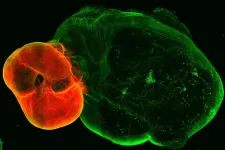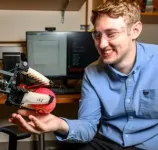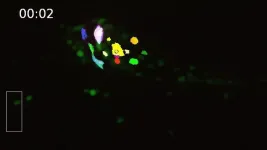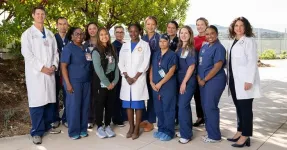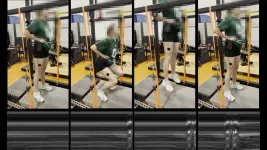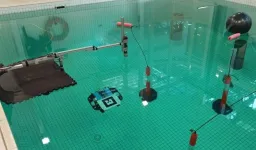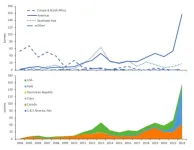(Press-News.org) A new organoid model of the dopaminergic system sheds lights on its intricate functionality and potential implications for Parkinson’s disease. The model, developed by the group of Jürgen Knoblich at the Institute of Molecular Biotechnology (IMBA) of the Austrian Academy of Sciences, replicates the dopaminergic system’s structure, connectivity, and functionality. The study, published on December 5 in Nature Methods, also uncovers the enduring effects of chronic cocaine exposure on the dopaminergic circuit, even after withdrawal.
A completed run, the early morning hit of caffeine, the smell of cookies in the oven - these rewarding moments are all due to a hit of the neurotransmitter dopamine, released by neurons in a neural network in our brain, called the “dopaminergic reward pathway”. Apart from mediating the feeling of “reward”, dopaminergic neurons also play a crucial role in fine motor control, which is lost in diseases such as Parkinson’s disease. Despite dopamine’s importance, key features of the system are not yet understood, and no cure for Parkinson’s disease exists. In their new study, the group of Jürgen Knoblich at IMBA developed an organoid model of the dopaminergic system, which not only recapitulates the system’s morphology and nerve projections, but also its functionality.
A model of Parkinson’s disease
Tremor and a loss of motor control are characteristic symptoms of Parkinson’s disease and are due to a loss of neurons that release the neurotransmitter dopamine, called dopaminergic neurons. When dopaminergic neurons die, fine motor control is lost and patients develop tremors and uncontrollable movements. Although the loss of dopaminergic neurons is crucial in the development of Parkinson’s disease, the mechanisms how this happens, and how we can prevent – or even repair – the dopaminergic system is not yet understood.
Animal models for Parkinson’s disease have provided some insight into Parkinsons disease, however as rodents do not naturally develop Parkinson’s disease, animal studies proved unsatisfactory in recapitulating hallmark features of the disease. In addition, the human brain contains many more dopaminergic neurons, which also wire up differently within the human brain, sending projections to the striatum and the cortex. “We sought to develop an in vitro model that recapitulates these human features in so called brain organoids”, explains Daniel Reumann, previously a PhD student in the lab of Jürgen Knoblich at IMBA, and first author of the paper. “Brain organoids are human stem cell derived three-dimensional structures, which can be used to understand both human brain development, as well as function”, he explains further.
The team first developed organoid models of the so-called ventral midbrain, striatum and cortex – the regions linked by neurons in the dopaminergic system – and then developed a method for fusing these organoids together. As happens in the human brain, the dopaminergic neurons of the midbrain organoid send out projections to the striatum and the cortex organoids. “Somewhat surprisingly, we observed a high level of dopaminergic innervation, as well as synapses forming between dopaminergic neurons and neurons in striatum and cortex”, Reumann recalls.
To assess whether these neurons and synapses are functional, the team collaborated with Cedric Bardy’s group at SAHMRI and Flinders University, Australia, to investigate if neurons in this system would start to form functional neural networks. And indeed, when the researchers stimulated the midbrain which contains dopaminergic neurons, neurons in the striatum and cortex responded to the stimulation. “We successfully modelled the dopaminergic circuit in vitro, as the cells not only wire correctly, but also function together”, Reumann sums up.
The organoid model of the dopaminergic system could be used to improve cell therapies for Parkinson’s disease. In first clinical studies, researchers have injected precursors of dopaminergic neurons into the striatum, to try and make up for the lost natural innervation. However, these studies have had mixed success. In collaboration with the lab of Malin Parmar at Lund University, Sweden, the team demonstrated that dopaminergic progenitor cells injected into the dopaminergic organoid model mature into neurons and extend neuronal projections within the organoid. “Our organoid system could serve as a platform to test conditions for cell therapies, allowing us to observe how precursor cells behave in a three-dimensional human environment”, Jürgen Knoblich, the study’s corresponding author, explains. “This allows researchers to study how progenitors can be differentiated more efficiently and provides a platform which allows to study how to recruit dopaminergic axons to target regions, all in a high-throughput manner.”
Insights into the reward system
Dopaminergic neurons also fire whenever we feel rewarded, thus forming the basis of the “reward pathway” in our brains. But what happens when dopaminergic signaling is perturbed, such as in addiction? To investigate this question, the researchers made use of a well-known dopamine reuptake inhibitor, cocaine. When the organoids were exposed to cocaine chronically, over 80 days, the dopaminergic circuit changed functionally, morphologically and transcriptionally. These changes persisted, even when cocaine exposure was stopped 25 days before the end of the experiment, which simulated the withdrawal condition. “Even after almost a month after stopping cocaine exposure, the effects of cocaine on the dopaminergic circuit were still visible, which means that we can now investigate what the long-term effects of dopaminergic overstimulation are in a human-specific in vitro system”, Reumann summarizes.
About IMBA
IMBA - Institute of Molecular Biotechnology - is one of the leading biomedical research institutes in Europe. IMBA is located at the Vienna BioCenter, a vibrant cluster of research institutes, universities and biotech companies in Austria. IMBA is an institute of the Austrian Academy of Sciences, the leading national sponsor of non-university academic research. Research topics pursued at IMBA include organoid and developmental biology, neuroscience, RNA biology and chromosome biology. For further information, please visit imba.oeaw.ac.at or follow us on social media.
Research in the lab of Jürgen Knoblich for this publication was funded by the ERC under the European Union’s Horizon 2020 program, the Austrian Federal Ministry of Education, Science, and Research, the Austrian Academy of Sciences, the City of Vienna, the Austrian Science Fund and the Austrian Lotteries.
END
Unlocking the secrets of the brain’s dopaminergic system
Breakthrough organoid model replicates essential neural network
2023-12-05
ELSE PRESS RELEASES FROM THIS DATE:
Enhanced AI tracks neurons in moving animals
2023-12-05
Recent advances allow imaging of neurons inside freely moving animals. However, to decode circuit activity, these imaged neurons must be computationally identified and tracked. This becomes particularly challenging when the brain itself moves and deforms inside an organism’s flexible body, e.g. in a worm. Until now, the scientific community has lacked the tools to address the problem.
Now, a team of scientists from EPFL and Harvard have developed a pioneering AI method to track neurons inside moving and deforming animals. The study, now published ...
UC San Diego Health recognized as leader in high quality OB/GYN care
2023-12-05
UC San Diego Health is recognized as a 2023-2024 High Performing Hospital for Maternity Care, which is the highest award a hospital can earn by U.S. News & World Report for obstetric and infant care.
To be recognized as High Performing in Maternity Care, hospitals must meet high standards in caring for patients with uncomplicated pregnancies, such as low cesarean section rates, low newborn complication rates, offering transparency on racial and ethnic disparities, and other measures.
“It is an honor to receive this prominent recognition, ...
Mental health crisis highlights access challenges
2023-12-05
The ongoing mental health crisis is causing significant challenges for many psychologists as they grapple with demand fueled by patients presenting with increasingly severe symptoms year after year, according to APA’s 2023 Practitioner Pulse Survey.
The survey, which was completed by 561 licensed practicing psychologists between Aug. 30 and Sept. 29, 2023, found that not only did more than half of psychologists (52%) say that they were seeing an increase in severity of symptoms among their patients, but 41% said that they were seeing ...
Wearable ultrasound monitor can aid rehabilitation from injury #Acoustics23
2023-12-05
SYDNEY, Dec. 5, 2023 – Millions suffer from musculoskeletal injuries every year, and the recovery process can often be long and difficult. Patients typically undergo rehabilitation, slowly rebuilding muscle strength as their injuries heal. Medical professionals routinely evaluate a patient’s progress via a series of tasks and exercises. However, because of the dynamic nature of these exercises, obtaining a clear picture of real-time muscle function is extremely challenging.
Parag Chitnis of George Mason University led a team that developed a wearable ultrasound system that can produce clinically relevant information about muscle function during dynamic physical activity. He ...
Bird feeding may give humans something to chirp about
2023-12-05
Ashley Dayer hopes to peck away at the notion that bird feeding is simply for the birds.
Associate professor in the Department of Fish and Wildlife Conservation at Virginia Tech, Dayer is the lead author of an article published in People and Nature that argues not only for the acknowledgment of the activity’s benefit to humans, but that it should play a role in public guidance and policy.
“Wildlife agencies and others making decisions on managing bird feeding need to be considering not only what the science is behind what’s going on with birds, but also the science behind what’s going on with people,” ...
Using AI to find microplastics
2023-12-05
An interdisciplinary research team from the University of Waterloo is using artificial intelligence (AI) to identify microplastics faster and more accurately than ever before.
Microplastics are commonly found in food and are dangerous pollutants that cause severe environmental damage – finding them is the key to getting rid of them.
The research team’s advanced imaging identification system could help wastewater treatment plants and food production industries make informed decisions ...
Eco-friendly glue breakthrough designed by Cal Poly chemistry team receives patent
2023-12-05
An innovative, ecofriendly glue designed by a Cal Poly chemistry research team in collaboration with an East Coast company has been approved for a U.S. government patent.
The patent, approved Nov. 21, creates a pathway for proprietary commercial production of the glue innovation under the direction of the Massachusetts-based company Geisys Ventures with involvement of Cal Poly chemistry faculty and students in research and development as part of a memorandum of understanding between the university and Geisys. The new adhesive has potential to reduce landfill waste and positively impact the environment on a broad scale.
The product, to be formally commercialized under the ...
Underwater vehicle AI model could be used in other adaptive control systems
2023-12-05
Unmanned Underwater Vehicles (UUVs) are used around the world to conduct difficult environmental, remote, oceanic, defence and rescue missions in often unpredictable and harsh conditions.
A new study led by Flinders University and French researchers has now used a novel bio-inspired computing artificial intelligence solution to improve the potential of UUVs and other adaptive control systems to operate more reliability in rough seas and other unpredictable conditions.
This innovative approach, using the Biologically-Inspired Experience Replay (BIER) method, has been published by the Institute of Electrical and Electronics Engineers journal IEEE Access.
Unlike conventional ...
Sugar permeation discovered in plant aquaporins
2023-12-05
Aquaporins, which move water through membranes of plant cells, were not thought to be able to permeate sugar molecules, but University of Adelaide researchers have observed sucrose transport in plant aquaporins for the first time, challenging this theory.
The finding, made by researchers from the School of Agriculture, Food and Wine, widens the concept of aquaporins’ role in plant biology and will have implications for the bioengineering of plants for food production and plant survival.
Aquaporins, which belong to a class of membrane ...
American Eel as an emerging consumer target
2023-12-05
Research led by Hiromi Shiraishi, researcher at Chuo University, indicated a steep rise in the importation of American Eel (Anguilla rostrata) live fry to East Asia for aquaculture purposes. This surge poses a potential threat to the already endangered species, further depleting the resources of this species. Japan relies on imports for two-thirds of its eel consumption and it is believed that a significant quantity of American Eel is included in these imports. As a major consumer of eels, Japan is urged to take a leading role in ensuring the sustainable utilisation of eel species, including ...
LAST 30 PRESS RELEASES:
Application of orthogonal CNOP-I in a convection-allowing ensemble prediction system based on CMA-MESO for improving extreme precipitation skill
Study suggests bamboo has ‘superfood’ potential
Hidden heart-care gaps among Asian American patients
Blood test predicts which patients with lung cancer will benefit from newly approved immunotherapy drug
SwRI’s Dr. Michael Davis named SPIE Fellow
Exposure to “forever chemicals” linked to higher risk of gestational diabetes, major review finds
Insilico Medicine integrates Nach01 Foundation Model with Microsoft Discovery to enable AI-native, enterprise-ready drug discovery workflows
New study reveals precursors for forecasting summer clustered extreme precipitation events in Northeast China
A bacterial toxin can counteract colorectal cancer growth
Frozen hydrogen cyanide ‘cobwebs’ offer clues to origin of life
Physics of foam strangely resembles AI training
Bis-pseudoindoxyls: a new class of single benzene-based fluorophores for bioimaging applications
Blocking a cancer-related pathway helps reduce spine deformities due to genetic disorder, finds new study
New study explores therapeutic potential of CRISPRCas3 genome-editing system
Korea University researchers revive an abandoned depression drug target using structurally novel NK1 receptor inhibitors
Jeonbuk National University researchers highlight advancements in chemical looping fluidized bed reactors
Tyrannosaurus rex grew up slowly: New study reveals the “king of dinosaurs” kept growing until age 40
Commercial water dispenser machines may contain more contamination than tap water
Death and doctors: New WSU study looks at medical student education on end-of-life care
The best hydrogen for heavy-duty transport is locally produced and green
Pregnancy-related high blood pressure varied among Asian, Pacific Islander subgroups
Measuring movement creates new way to map indoor air pollution
Europe’s crop droughts to get worse even as rain increases
New study identifies signature in blood to better predict type 2 diabetes risk
Research spotlight: developing “smart” nanoparticles to deliver targeted gene therapy in osteoarthritis
A CRISPR fingerprint of pathogenic C. auris fungi
Time warp: How marketers express time can affect what consumers buy
CBD treatment reverses key effects of fetal alcohol spectrum disorder in a mouse model
Blood sugar spikes linked to higher risk of Alzheimer's disease
Staying single for longer affects young people’s well-being
[Press-News.org] Unlocking the secrets of the brain’s dopaminergic systemBreakthrough organoid model replicates essential neural network
